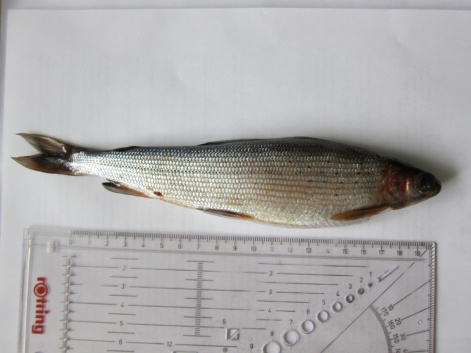The study of Siberian grayling will help preserve marine fish
15 September 2021 г.

For the normal growth and development of many living organisms, including humans, physiologically valuable long-chain polyunsaturated fatty acids, in particular, eicosapentaenoic and docosahexaenoic (omega-3 PUFAs) ones, must be present in food. Currently, humanity is experiencing a deficiency of omega-3 PUFAs. The main source of these substances in our diet is fish. However, in order to obtain sufficient quantities of essential acids from the grown fish, this feed needs feed made from wild inhabitants of reservoirs. This causes overfishing and a significant reduction in natural populations of aquatic organisms.
Scientists from the Federal Research Center "KSC SB RAS" and Siberian Federal University found out that grayling, one of the most important commercial fish in the Yenisei River, can independently synthesize polyunsaturated fatty acids. This makes it possible, when using this type of fish in aquaculture, to reduce the content of expensive components produced from marine fish in its diet.
The researchers studied the content and composition of fatty acids in the brain, liver, heart, intestines, caviar and milk, muscles and internal fat of the Yenisei grayling Thymallus baicalensis. They determined whether intermediate compounds involved in the formation of docosahexaenoic acid were present in these tissues. The presence of such markers allows saying whether the synthesis of omega-3 PUFAs is taking place in the tissues.
The maximum rate of synthesis was detected in the brain, that is, in the nerve tissues of the fish. Scientists explain this by the fact that the brain needs more docosahexaenoic acid to function.
The researchers also found that male milk contains quite a lot of furan fatty acids as compared to other fish species. Scientists note that the effect of these substances on human health is not fully understood, but it is likely that they can be beneficial for the cardiovascular system, as they inhibit lipid oxidation and reduce inflammation.
“When fish are raised in aquaculture, fish being unable to synthesize omega-3 PUFAs on their own, they have to be fed with expensive feed containing these acids. Firstly, the fish itself needs this for normal development, and secondly, in order to get a product that is useful for humans, being rich in omega-3 PUFAs. Conventional feed is based on fat obtained from marine wild fish. It turns out that fish are fed with fish and, thereby, the number of natural populations is reduced. If you raise fish species that themselves can at least partially synthesize omega-3 PUFAs, then cheaper feed can be developed for them, for example, from vegetable oils. Thus, fish will be able to independently produce the necessary acids. Therefore, we will not only reduce the cost of food and get fish rich in the necessary substances, but also preserve wild fish species.
“We found substances indicative of the DHA synthesis in all he studied grayling tissues, however, the efficiency of this synthesis has yet to be clarified with the help of genetic analysis, which we plan to do by the end of this year, ” explains Doctor of Biological Sciences, Leading Researcher at the Institute of Biophysics of the KSC SB RAS, associate professor of SFU, Olesya Makhutova.
The World Health Organization recommends 0.25 to 2 grams of eicosapentaenoic and docosahexaenoic acids per day for the prevention of cardiovascular disease. Their daily dose is contained in 50-400 grams of grayling fillets. In addition, scientists found out that grayling fat is comparable to cod liver oil in terms of omega-3 PUFA content.
“About 10 grams of cod liver contains one gram of eicosapentaenoic acid and one gram of docosahexaenoic acid, which is the same as in the grayling fat. Thus, grayling fat can be a valuable food because of its low saturated fatty acid content, low or no cholesterol, and high omega-3 PUFA content. Thus, I recommend not throwing it away, but using it for food, ” recommends Olesya Makhutova.
This work was supported by the Russian Foundation for Basic Research.
Share:
